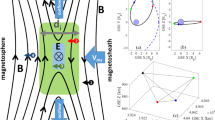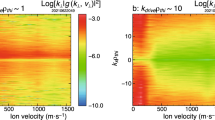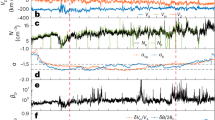Abstract
The idea of ‘frozen-in’ magnetic field lines for ideal plasmas1 is useful to explain diverse astrophysical phenomena2, for example the shedding of excess angular momentum from protostars by twisting of field lines frozen into the interstellar medium. Frozen-in field lines, however, preclude the rapid changes in magnetic topology observed at high conductivities, as in solar flares2,3. Microphysical plasma processes are a proposed explanation of the observed high rates4,5,6, but it is an open question whether such processes can rapidly reconnect astrophysical flux structures much greater in extent than several thousand ion gyroradii. An alternative explanation7,8 is that turbulent Richardson advection9 brings field lines implosively together from distances far apart to separations of the order of gyroradii. Here we report an analysis of a simulation of magnetohydrodynamic turbulence at high conductivity that exhibits Richardson dispersion. This effect of advection in rough velocity fields, which appear non-differentiable in space, leads to line motions that are completely indeterministic or ‘spontaneously stochastic’, as predicted in analytical studies10,11,12,13. The turbulent breakdown of standard flux freezing at scales greater than the ion gyroradius can explain fast reconnection of very large-scale flux structures, both observed (solar flares and coronal mass ejections) and predicted (the inner heliosheath, accretion disks, γ-ray bursts and so on). For laminar plasma flows with smooth velocity fields or for low turbulence intensity, stochastic flux freezing reduces to the usual frozen-in condition.
This is a preview of subscription content, access via your institution
Access options
Subscribe to this journal
Receive 51 print issues and online access
$199.00 per year
only $3.90 per issue
Buy this article
- Purchase on Springer Link
- Instant access to full article PDF
Prices may be subject to local taxes which are calculated during checkout




Similar content being viewed by others
References
Alfvén, H. On the existence of electromagnetic-hydrodynamic waves. Ark. Mat. Astron. Fys. 29, 1–7 (1942)
Kulsrud, R. Plasma Physics for Astrophysics (Princeton Univ. Press, 2005)
Priest, E. R. & Forbes, T. G. Magnetic Reconnection: MHD Theory and Applications (Cambridge Univ. Press, 2000)
Che, H., Drake, J. F. & Swisdak, M. A current filamentation mechanism for breaking magnetic field lines during reconnection. Nature 474, 184–187 (2011)
Daughton, W. et al. Role of electron physics in the development of turbulent magnetic reconnection in collisionless plasmas. Nature Phys. 7, 539–542 (2011)
Moser, A. L. & Bellan, P. M. Magnetic reconnection from a multiscale instability cascade. Nature 482, 379–381 (2012)
Lazarian, A. & Vishniac, E. T. Reconnection in a weakly stochastic field. Astrophys. J. 517, 700–718 (1999)
Eyink, G. L., Lazarian, A. & Vishniac, E. T. Fast magnetic reconnection and spontaneous stochasticity. Astrophys. J. 743, 51 (2011)
Richardson, L. F. Atmospheric diffusion shown on distance-neighbor graph. Proc. R. Soc. Lond. A 110, 709–737 (1926)
Bernard, D., Gawȩdzki, K. & Kupiainen, A. Slow modes in passive advection. J. Stat. Phys. 90, 519–569 (1998)
E, W. & Vanden Eijnden, E. Vanden Eijnden, E. Generalized flows, intrinsic stochasticity, and turbulent transport. Proc. Natl Acad. Sci. USA 97, 8200–8205 (2000)
Chaves, M., Gawȩdzki, K., Horvai, P., Kupiainen, A. & Vergassola, M. Lagrangian dispersion in Gaussian self-similar velocity ensembles. J. Stat. Phys. 113, 643–692 (2003)
Eyink, G. L. Turbulent diffusion of lines and circulations. Phys. Lett. A 368, 486–490 (2007)
Frisch, U. Turbulence 52–56 (Cambridge Univ. Press, 1995)
Leamon, R. J., Smith, C. W., Ness, N. F., Matthaeus, W. H. & Wong, H.-K. Observational constraints on the dynamics of the interplanetary magnetic field dissipation range. J. Geophys. Res. 103, 4775–4787 (1998)
Chepurnov, A. & Lazarian, A. Extending the big power law in the sky with turbulence spectra from Wisconsin Hα Mapper data. Astrophys. J. 710, 853–858 (2010)
Eyink, G. L. Stochastic line motion and stochastic flux conservation for nonideal hydromagnetic models. J. Math. Phys. 50, 083102 (2009)
Eyink, G. L. Fluctuation dynamo and turbulent induction at small Prandtl number. Phys. Rev. E 82, 046314 (2010)
Sawford, B. L., Yeung, P. K. & Hackl, J. F. Reynolds number dependence of relative dispersion statistics in isotropic turbulence. Phys. Fluids 20, 065111 (2008)
Eyink, G. L. Stochastic flux freezing and magnetic dynamo. Phys. Rev. E 83, 056405 (2011)
Busse, A., Müller, W.-C., Homann, H. & Grauer, R. Statistics of passive tracers in three-dimensional magnetohydrodynamic turbulence. Phys. Plasmas 14, 122303 (2007)
Boldyrev, S. Spectrum of magnetohydrodynamic turbulence. Phys. Rev. Lett. 96, 115002 (2006)
Beresnyak, A. Spectral slope and Kolmogorov constant of MHD turbulence. Phys. Rev. Lett. 106, 075001 (2011)
Li, Y. et al. A public turbulence database cluster and applications to study Lagrangian evolution of velocity increments in turbulence. J. Turbul. 9, N31 (2008)
The JHU Turbulence Database Cluster. http://turbulence.pha.jhu.edu (2012)
Goldreich, P. & Sridhar, S. Toward a theory of interstellar turbulence. 2: Strong Alfvénic turbulence. Astrophys. J. 438, 763–775 (1995)
Hentschel, H. G. E. & Procaccia, I. Relative diffusion in turbulent media: the fractal dimension of clouds. Phys. Rev. A 29, 1461–1470 (1984)
Kowal, G., Lazarian, A., Vishniac, E. T. & Otmianowska-Mazur, K. Numerical tests of fast reconnection in weakly stochastic magnetic fields. Astrophys. J. 700, 63–85 (2009)
Schekochihin, A. A. et al. Astrophysical gyrokinetics: kinetic and fluid turbulent cascades in magnetized weakly collisional plasmas. Astrophys. J. 182 (suppl.). 310–377 (2009)
Ciaravella, A. & Raymond, J. C. The current sheet associated with the 2003 November 4 coronal mass ejection: density, temperature, thickness, and line width. Astrophys. J. 686, 1372–1382 (2008)
Acknowledgements
The work of the group at the Johns Hopkins University was supported by the US NSF grant CDI-II: CMMI 0941530, and the database infrastructure was supported by US NSF grant OCI-108849 and JHU’s Institute for Data Intensive Engineering & Science. The work of E.V. was supported by the National Science and Engineering Research Council of Canada. The authors thank R. Westermann for his contributions to the visualization tool and A. Lazarian for discussions of the science.
Author information
Authors and Affiliations
Contributions
All of the authors made significant contributions to this work. H.A. carried out the simulations of MHD turbulence. K.K., R.B., A.S. and C.M. were primarily responsible for the construction of the MHD database and online analysis tools. G.E. designed the study and developed the numerical algorithms for stochastic flux freezing. C.L. generated the simulation results using the database. K.B. developed the visualization of the archived MHD data. G.E., E.V., C.L. and C.M. analysed the simulation results and were primarily responsible for writing the paper. All authors discussed the results and commented on the paper.
Corresponding author
Ethics declarations
Competing interests
The authors declare no competing financial interests.
Supplementary information
Supplementary Information
This file contains Supplementary Text and Data, Supplementary Figures 1-2 and Supplementary References. (PDF 1227 kb)
Ohmic electric fields in the archived MHD simulation
The magnitude of the Ohmic electric field EOhm=J/σ=c∇×B/4πσ is plotted normalized by the rms value E'mot of the motional field Emot=-v×B/c, for one 10243 time-slice of the archived MHD turbulence simulation. This is the same field plotted in panel a of Fig.2, with the same volume rendering and color coding, but at higher resolution and in a rotating frame. The transparency and rotation provide a three-dimensional view, showing EOhm / E'mot is negligible outside thin, intense current sheets sparsely distributed over the volume. Richardson dispersion occurs at points throughout the flow and is not associated with the strong current sheets. (MOV 24045 kb)
Stochastic flux-freezing for resistive MHD
Shown is an animation of Figure 1, illustrating the numerical evaluation of the pointwise magnetic field via stochastic flux-freezing. First, stochastic trajectories are integrated backward to the starting time, when initial field vectors are sampled. Second, the initial vectors are transported along the trajectories to the final point. Third, these “virtual” vectors arriving at that point are averaged to obtain the actual magnetic field. Physically, all of the dynamics is forward in time and the first backward-integration step is only a convenient algorithm to obtain the ensemble of stochastic trajectories which arrive simultaneously at the chosen final point. (MOV 33269 kb)
Rights and permissions
About this article
Cite this article
Eyink, G., Vishniac, E., Lalescu, C. et al. Flux-freezing breakdown in high-conductivity magnetohydrodynamic turbulence. Nature 497, 466–469 (2013). https://doi.org/10.1038/nature12128
Received:
Accepted:
Published:
Issue Date:
DOI: https://doi.org/10.1038/nature12128
This article is cited by
-
Spontaneously Stochastic Arnold’s Cat
Arnold Mathematical Journal (2023)
-
Magnetic reconnection: MHD theory and modelling
Living Reviews in Solar Physics (2022)
-
From the butterfly effect to spontaneous stochasticity in singular shear flows
Communications Physics (2020)
-
Lagrangian Averaged Stochastic Advection by Lie Transport for Fluids
Journal of Statistical Physics (2020)
-
Effective Resistivity in Collisionless Magnetic Reconnection
Scientific Reports (2018)
Comments
By submitting a comment you agree to abide by our Terms and Community Guidelines. If you find something abusive or that does not comply with our terms or guidelines please flag it as inappropriate.



